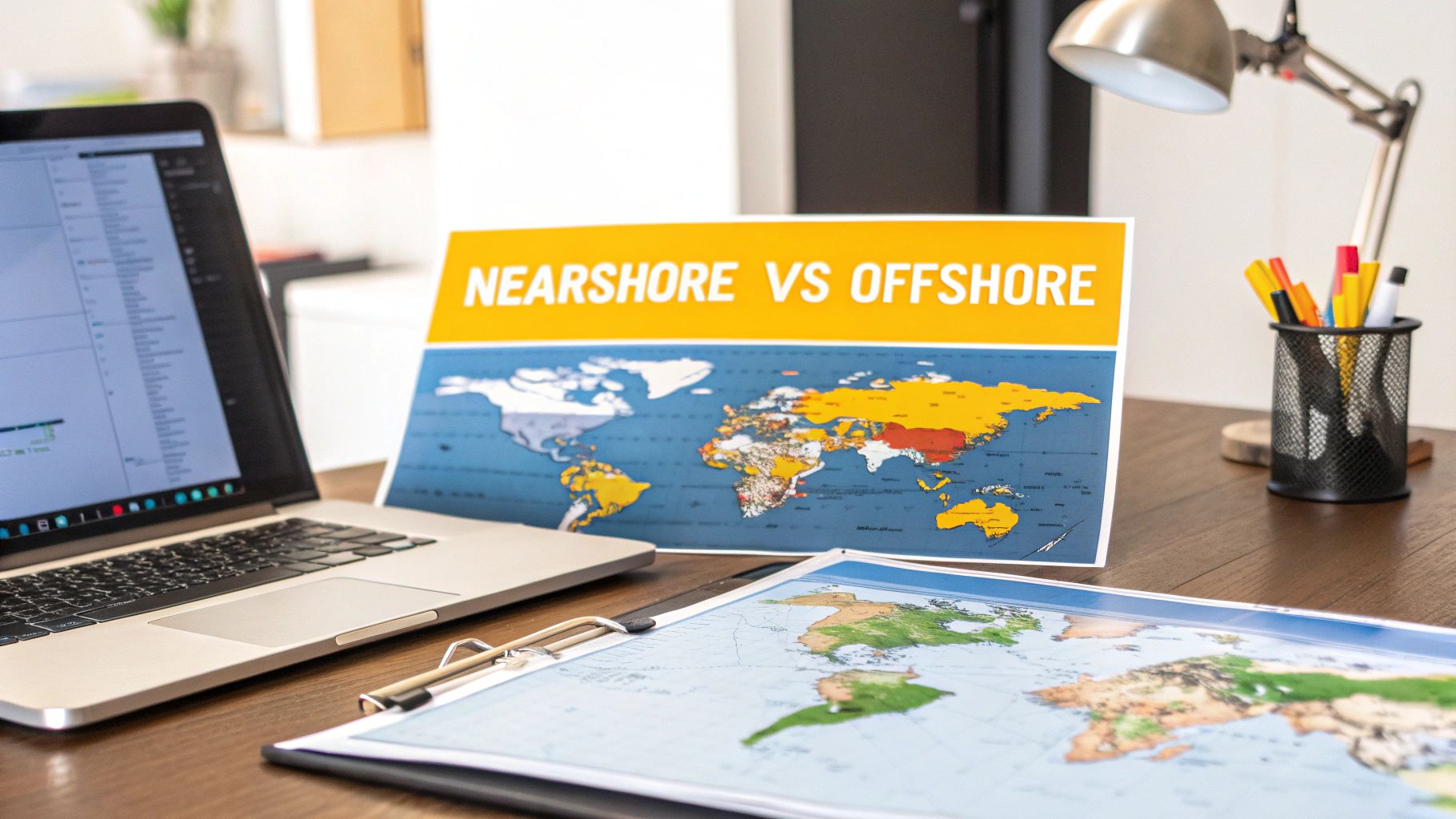Nearshore vs Offshore Outsourcing: Choose the Best Option

When you get right down to it, the choice between nearshore and offshore outsourcing boils down to a classic trade-off: cost versus collaboration. With nearshore outsourcing, you're getting teams in neighboring countries, which makes real-time collaboration much easier. On the other hand, offshore outsourcing opens the door to significant cost savings by working with teams in more distant parts of the world.
The right answer for your business really depends on what you value more—seamless, in-the-moment communication or squeezing the absolute most out of your budget.
The Outsourcing Decision: Nearshore vs. Offshore

Deciding on an outsourcing model isn't just about picking a spot on a map; it's a strategic business move. This choice will fundamentally shape how your teams work together, the pace of your projects, and your ultimate return on investment. The entire nearshore vs. offshore debate really centers on how you balance these critical business priorities.
The global outsourcing market is ballooning as more companies hunt for specialized skills they can't find or afford locally. Industry projections show the market is expected to hit a staggering $620 billion by 2032. The US is still the biggest player, holding a dominant 60% market share, which tells you just how much businesses are relying on external talent for high-value work like IT and data analytics. You can dig deeper into the outsourcing market's trajectory to see where things are headed.
To make a smart call, you first have to get a handle on the core DNA of each model.
Quick Look: Nearshore vs. Offshore at a Glance
Let's break it down with a quick comparison. This table gives you a high-level summary to help you see which model might fit your company's immediate needs.
| Factor | Nearshore Outsourcing | Offshore Outsourcing |
|---|---|---|
| Time Zone | Minimal difference (0-3 hours) | Significant difference (5-12+ hours) |
| Cost | Moderate savings | Highest savings |
| Collaboration | Real-time, highly interactive | Asynchronous, requires planning |
| Cultural Alignment | High similarity | Lower similarity |
| Travel | Easy, short-haul flights | Difficult, long-haul flights |
| Ideal For | Agile projects, complex tasks | Cost-driven, 24/7 support, defined tasks |
As you can see, there isn't one "better" option—it's all about fit.
The best model isn't determined by which is "better" overall, but by which one best fits your project's specific requirements, budget constraints, and communication style.
Nearshore partnerships—think US companies working with teams in Latin America—are fantastic when you need agility and constant communication. But if cost is your number one driver and the work is clearly defined, an offshore partnership, perhaps with a team in Southeast Asia, is often unbeatable.
The Case for Nearshore Outsourcing

While the rock-bottom prices of offshore models can look appealing on paper, many experienced business leaders are shifting their focus to nearshore outsourcing. This isn't just about geography. It’s a strategic move that values seamless integration and tight collaboration over simply chasing the lowest possible cost.
The real magic of nearshore is its ability to feel like a natural extension of your home team, not a disconnected vendor halfway around the world. The biggest reason for this shift? Time zone alignment.
When your external team works the same hours you do, everything changes. The frustrating communication delays that plague many offshore projects simply disappear. Instead of sending an email and waiting 24 hours for a reply, your teams can hop on a quick call and solve a problem in minutes.
A Perfect Match for Agile and Fast-Paced Work
This real-time connection is more than a simple convenience—it’s a powerful advantage, especially if your team relies on agile development. Agile methodologies live and breathe on constant communication, quick feedback, and rapid iterations. Think daily stand-ups, sprint planning sessions, and impromptu problem-solving huddles.
Nearshore development makes real-time collaboration possible by aligning teams by time zone, not just by office walls. This shared work cycle is the secret sauce that makes agile work effectively in a distributed setup.
With a nearshore partner, your team can maintain the same rhythm and energy as if everyone were in the same building. This synchronization is essential for complex projects that demand discovery, flexibility, and the ability to pivot on a dime. For a more detailed breakdown, check out our guide on nearshore software development to see how you can make this model work for you.
The Overlooked Power of Cultural Connection
Beyond the clock, cultural and linguistic similarities are a massive, often underestimated, factor in a partnership's success. When a US company partners with a team in Latin America, for example, you often find a strong overlap in business etiquette, communication norms, and work ethic.
This shared cultural context smooths over the friction that can come from misinterpretations or different professional standards. It helps build genuine rapport and trust much faster, leading to a team that feels more cohesive and works more effectively. When your partners just get the nuances of your communication style, the quality of your collaboration skyrockets.
The industry data backs this up. The nearshore outsourcing market is projected to grow from $2.67 billion in 2025 to nearly $4 billion by 2034. This isn't a fluke; it shows a clear trend toward models that strike a smart balance between cost and operational excellence.
Ultimately, opting for nearshore outsourcing is a deliberate choice to prioritize quality, speed, and collaboration. It’s the right fit for businesses that want a partner who acts less like a vendor and more like an integral part of the team.
The Power of Offshore Outsourcing

When the conversation turns to maximizing cost savings, offshore outsourcing is almost always part of the discussion. This model operates on a powerful premise: tapping into a global talent pool for a fraction of what it costs to hire at home or even in neighboring countries. For any business where the budget is the number one driver, going offshore is often the most logical move.
The financial upside is hard to ignore. By partnering with firms in talent-rich regions like India, Southeast Asia, or Eastern Europe, companies can seriously slash their operational costs. The primary reason for these savings comes down to the stark difference in labor costs for highly skilled professionals.
The Unbeatable Economics of Offshore Talent
The sheer scale of the savings is what makes the nearshore vs offshore outsourcing debate so critical for finance-minded leaders. In places like Southeast Asia and Eastern Europe, you can find developers with hourly rates between $20 and $60. That’s a world away from North American rates, which typically fall between $120 and $150 per hour for similar expertise.
This cost gap is what allows companies to either build much larger teams or significantly extend their project timelines without breaking the bank.
This economic reality is fueling massive growth. Offshore outsourcing is the fastest-growing part of the global market, with an estimated annual growth rate of 12.5%. By 2028, experts project it will capture 45% of the entire world outsourcing market, a testament to its enduring appeal.
But getting to those savings means you have to be realistic about the challenges. The biggest one? Managing teams across massive time zone differences.
"Offshore outsourcing trades real-time collaboration for around-the-clock productivity. Success hinges on mastering asynchronous communication and establishing exceptionally clear, well-documented workflows."
This trade-off makes offshore partnerships a great fit for projects that have a clearly defined scope and don't rely on constant, spontaneous back-and-forth.
Navigating Operational Realities
To make an offshore team work, you have to be intentional and structured about closing the distance. Communication can't be an afterthought; it has to be planned meticulously.
Key strategies for offshore success include:
- Establishing a time-zone overlap: Even an hour or two each day for real-time meetings and quick check-ins can make all the difference.
- Investing in robust project management tools: Platforms like Jira, Asana, or Trello become your single source of truth, keeping everyone aligned on tasks and deadlines, no matter when they work.
- Prioritizing comprehensive documentation: Every requirement, process, and decision needs to be written down clearly. This cuts down on the ambiguity and misunderstandings that can creep in due to cultural or language differences.
For complex projects, like building a new platform from the ground up, this level of detail is non-negotiable. Our guide on custom web application development emphasizes the need for detailed specs, a practice that becomes even more vital in an offshore setup.
At the end of the day, offshore outsourcing is a strategic play for businesses that have mature processes and a laser focus on cost. When you plan it carefully and manage it well, it opens the door to a global workforce and an economic advantage that's tough to beat.
A Head-to-Head Model Comparison

Choosing the right outsourcing model means looking past the surface-level benefits and getting into the nitty-gritty of what impacts your project's success and your bottom line. The real differences between nearshore and offshore outsourcing don't show up in a sales pitch; they emerge in the day-to-day grind of getting work done.
Let's break down the core elements head-to-head. We’ll look at five key areas: cost and ROI, communication, time zone alignment, talent pool access, and risk management. This isn't about generic pros and cons. It's a practical analysis to help you see which model truly fits your company's operational style, project complexity, and strategic goals.
Cost and Return on Investment
At first glance, offshore outsourcing looks like a no-brainer on price. You might see hourly rates in Southeast Asia advertised for as low as $20-$60, which is a world away from the $120-$150 per hour you'd pay for a developer in North America. Nearshore rates are a happy medium, offering solid savings without the sticker shock.
But smart leaders know to look beyond the hourly rate and consider the Total Cost of Ownership (TCO). This is where the story gets more interesting.
Offshore's lower rates can come with a catch. Big time zone gaps often mean you need more project management muscle just to keep everyone on the same page and avoid delays. When you add in the potential for rework caused by miscommunication or cultural differences, those "hidden" costs start to add up, stretching out your timeline and budget.
Nearshore outsourcing, with its higher hourly rates, often pulls ahead by delivering a stronger ROI through pure efficiency. When your team is working in a similar time zone, collaboration is just easier. This cuts down on management friction and helps you build and release faster. That speed can actually shorten the project timeline, sometimes making the total cost surprisingly close to—or even less than—an offshore project bogged down by delays.
Key Differentiator: Offshore is about minimizing direct labor costs, making it a great fit for budget-focused projects with a clearly defined scope. Nearshore is about maximizing operational efficiency, which typically delivers a higher ROI on complex, agile projects where speed and collaboration are everything.
Communication and Collaboration
Good communication is the glue that holds any project together, and this is where the two models really start to show their differences. The quality of your collaboration directly impacts not just the final product, but also your team’s ability to innovate and their overall morale.
Nearshore is practically built for real-time, hands-on collaboration. When your external team is only an hour or two away, synchronous communication becomes second nature. You can have daily stand-ups, jump on a quick call to solve a problem, and get immediate feedback—just like you would with your team down the hall. For anyone using agile methods, this is a massive win.
Offshore collaboration, on the other hand, is almost entirely asynchronous out of necessity. With an 8 to 12-hour time difference, you have to be incredibly disciplined with your communication. Everything depends on detailed documentation, organized task managers, and scheduled calls that often happen at odd hours for one team or the other. While it can work, it definitely slows down decision-making and makes it tough to tackle urgent issues on the fly.
Cultural affinity is another piece of the puzzle. Nearshore partners in Latin America often have more in common with U.S. businesses when it comes to communication styles and professional norms. This subtle alignment helps build rapport much faster and cuts down on misunderstandings, leading to a more cohesive, integrated team.
Time Zone Alignment
The time zone factor is so important it deserves its own spotlight. It's not just about scheduling meetings; it fundamentally changes your workflow, your team's responsiveness, and their productivity.
With nearshore partners, your workday overlap is nearly 100%. This is huge. It means your in-house staff and your outsourced team are online and available at the same time. A problem that pops up in the morning can be discussed, fixed, and resolved by the end of the day. This creates a tight, iterative loop that keeps the project moving forward without frustrating delays.
Offshore partnerships typically run on a "follow-the-sun" model. The big time gap means one team is clocking out just as the other is clocking in. While you can use this for 24/7 productivity on certain tasks—like running tests overnight or handling round-the-clock support—it creates a natural bottleneck for anything collaborative. A question you send at 4 PM your time might not even be seen until the next business day, effectively costing you 24 hours.
A Real-World Scenario:
- Nearshore: A critical bug is found at 10 AM. The product manager, a U.S. developer, and a nearshore QA engineer hop on a video call at 10:15 AM. By lunch, a fix is coded and pushed to the staging server for testing.
- Offshore: A critical bug is found at 10 AM U.S. time. An urgent ticket is filed for the offshore team, who are wrapping up their day. They see the ticket the next morning, investigate, and start working on a fix. Due to the time lag, a full day has passed before a solution is even ready for review.
Talent Pool and Specialized Skills
Both models open the door to a global talent pool, but the kind of talent you get access to is different. The right choice really depends on whether you need a massive workforce for a big project or a small team with very specific, niche skills.
Offshore hubs like India and the Philippines boast an enormous number of IT professionals. This scale is perfect for large-scale projects that need a lot of developers or for back-office functions where you're hiring dozens of people for similar roles. If you need sheer volume, offshore is tough to compete with.
Nearshore regions, especially in Latin America, have been pouring resources into tech education, and it shows. They have a fast-growing, highly skilled talent pool that’s particularly strong in modern tech stacks like AI, cloud, and mobile development. You’ll often find that nearshore partners have a high degree of specialization and are already well-versed in the agile practices you're using.
Detailed Factor Analysis: Nearshore vs. Offshore
To tie it all together, here’s a table that breaks down the nuanced differences across the most critical factors. Use it to map your specific project needs to the model that will serve you best.
| Evaluation Criteria | Nearshore Outsourcing (e.g., Latin America) | Offshore Outsourcing (e.g., Southeast Asia) | Best For |
|---|---|---|---|
| Total Cost of Ownership | Higher hourly rates but often lower TCO due to efficiency gains and reduced management overhead. | Lowest hourly rates but potential for hidden costs from rework, delays, and management oversight. | Offshore: Maximizing budget on well-defined projects. Nearshore: Optimizing ROI on complex, collaborative projects. |
| Collaboration Style | Real-time and synchronous. Ideal for agile methodologies, daily stand-ups, and rapid iteration. | Asynchronous by necessity. Requires meticulous documentation and planned communication windows. | Nearshore: Agile, fast-paced projects needing constant communication. Offshore: Projects with fixed scopes and minimal daily interaction. |
| Project Velocity | High. Problems are identified and solved within the same business day, maintaining project momentum. | Moderate. Communication delays between time zones can slow down decision-making and problem resolution. | Nearshore: Time-sensitive projects where speed to market is a priority. Offshore: Long-term projects where speed is secondary to cost. |
| Talent Access | Access to a highly skilled, specialized talent pool with strong cultural and linguistic alignment. | Access to a massive, diverse talent pool, ideal for scaling large teams for standardized tasks. | Offshore: Large-scale hiring and 24/7 operations. Nearshore: Finding specialized expertise and integrated team extensions. |
| Risk Management | Lower risk profile due to easier travel, similar legal frameworks, and stronger IP protection alignment. | Higher risk profile related to cultural gaps, communication delays, and differing legal/data privacy laws. | Nearshore: Projects with high IP sensitivity or complex compliance needs. Offshore: Non-core functions with well-established risk mitigation plans. |
Ultimately, the choice isn't about which model is "better" in a vacuum, but which one is the right strategic fit for your immediate project and long-term business goals.
Choosing the Right Model for Your Project
It's one thing to know the textbook differences between nearshore and offshore outsourcing, but it's another thing entirely to apply that to your real-world project. Let's be clear: there's no single "best" choice. The right answer depends completely on your project’s goals, how your team works, and what you’re trying to achieve strategically.
So, let's get practical. Here are some common business scenarios where one model is usually a much better fit than the other, and I'll break down exactly why.
When Nearshore Outsourcing Is the Right Call
Nearshore really shines when you need tight collaboration, speed, and specialized skills more than you need the absolute rock-bottom hourly rate. Think of it as the go-to model for complex, fast-moving projects that need to feel like an extension of your in-house team.
I’d strongly recommend a nearshore partner in these situations:
- Agile Software Development: If your team lives and breathes Agile or Scrum, you know how critical daily stand-ups, quick iterations, and constant feedback are. The minimal time zone difference with a nearshore partner makes this real-time collaboration not just possible, but smooth. It keeps the project humming along without the frustrating communication delays you'd get from a team 12 hours ahead.
- Projects with High IP Sensitivity: When you're working with proprietary code, sensitive customer data, or any valuable intellectual property, proximity is peace of mind. Nearshore countries often have legal frameworks and data protection laws that are much more aligned with the U.S. Plus, the ability to jump on a short flight for an in-person meeting adds a crucial layer of security and oversight.
- Complex UX/UI Design Projects: Great user experience doesn't happen in a vacuum; it requires a deep, ongoing conversation between designers, developers, and product managers. A nearshore team can jump into live brainstorming sessions, review user testing in real-time, and participate in design sprints. This ensures the final product is built on a shared vision, not on a trail of misunderstood emails.
A project with a fuzzy or evolving scope is almost always a prime candidate for a nearshore partnership. When you need to figure things out as you go, having your external team in a similar time zone is a massive strategic advantage.
As you consider bringing in external talent, it’s also smart to weigh this against other hiring models. Getting a handle on the differences between staff augmentation vs outsourcing can help you fine-tune your strategy even further.
When Offshore Outsourcing Makes More Sense
Don't count offshore out—it's still a powerhouse strategy when your main goals are cost efficiency and scale. It works brilliantly for well-defined, repeatable tasks that don't need constant, minute-by-minute collaboration.
Here’s where an offshore model is typically the clear winner:
- Large-Scale Back-Office Operations: Think data entry, transaction processing, or content moderation. For these functions, scale and cost are everything. Offshore partners can build large, dedicated teams to handle massive volumes of this work for a fraction of what it would cost stateside. This frees up your domestic team to focus on higher-value, strategic work.
- 24/7 Customer or Technical Support: That huge time zone difference can be your greatest asset. When your U.S. team is signing off, your offshore team is just getting started. This "follow-the-sun" model allows you to offer seamless, round-the-clock support, ensuring customers get help whenever they need it without burning out your local staff with night shifts.
- Long-Term Projects with a Fixed Scope: Got a big, well-documented project with crystal-clear deliverables? Migrating a legacy system or handling routine software maintenance are perfect examples. Since you don't need much spontaneous collaboration, the significant cost savings become the deciding factor.
Ultimately, the nearshore vs offshore outsourcing decision comes down to an honest look at your project's DNA. If it thrives on agility and close teamwork, you’re looking at nearshore. If it’s a cost-driven, high-volume task, offshore is likely your answer.
A Framework for Your Outsourcing Strategy
Deciding between nearshore and offshore outsourcing isn't just about comparing stats on a spreadsheet. It's about taking a hard, honest look at your own company—your project needs, your budget, and how your team actually works. This framework is designed to help you do just that, so you can build a partnership that truly fuels growth, not just trims expenses.
The first move is always an internal one. Before you even start looking at potential vendors, you need to get your own team aligned on what truly matters. This isn't a fluffy, high-level chat; it’s about getting into the nitty-gritty details that will ultimately define the success of your outsourcing relationship.
Start with These Critical Internal Questions
Get your key stakeholders in a room and hash out the answers to these questions. The goal is to build a clear picture of what you need, which will naturally point you toward the right outsourcing model.
- What’s our real, all-in budget? You have to think beyond simple hourly rates. What about the hidden costs? Consider the extra project management time an offshore team might require or the budget for travel to visit a nearshore partner.
- How vital is real-time collaboration? Be brutally honest here. Can your project succeed with well-documented tasks and asynchronous updates, or do you need the back-and-forth of daily stand-ups and instant feedback?
- What’s our appetite for risk? Think about everything from IP protection and data security to the simple risk of miscommunication. Nearshore partners often fall under legal systems similar to your own, which can make things like compliance much more straightforward.
- How fast do we really need to go? A tight deadline often demands the high-velocity teamwork that's easier with a nearshore team. If your timeline has more breathing room, the cost benefits of an offshore partner might become the more compelling factor.
Think of your answers as building a profile of your perfect partner. If you find yourself prioritizing speed, close collaboration, and lower risk, you're almost certainly leaning toward a nearshore solution. If cost savings is the non-negotiable priority, an offshore model is likely your best bet.
A Practical Checklist for Vetting Partners
Once you've settled on a model, the real work begins: finding the right firm. A great partner is far more than a vendor; they're a strategic extension of your own team. Use this checklist to dig deep and evaluate them properly.
Key Vetting Criteria:
- Technical Skills and Portfolio: Don't just take their marketing materials at face value. Demand case studies relevant to your industry. Review past projects. If you can, insist on conducting technical interviews with the actual developers who would be working on your account.
- Communication Infrastructure: How do they actually manage communication? Ask for a demo of their project management tools. For offshore candidates, press them on their specific strategies for making the time zone difference a non-issue.
- Security and Compliance Protocols: This is a deal-breaker. Ask for detailed documentation on their data security policies, physical office security, and any compliance certifications they hold (like SOC 2 or ISO).
- Cultural Fit and Client References: This is where you get the real story. Ask to speak with a few of their current or recent clients. A 15-minute call with a reference can tell you more about their reliability, problem-solving skills, and communication style than any sales pitch.
Choosing between nearshore and offshore is a major strategic move. By using this framework, you can get beyond the surface-level debate and make a confident decision that’s genuinely aligned with where your business is headed.
Frequently Asked Questions About Outsourcing
When you're weighing nearshore against offshore, a few practical questions always pop up. Getting clear answers is the only way to make a smart decision that actually helps your business. Let's dig into the most common ones I hear from clients.
Is Nearshore Really That Much More Expensive?
It’s true that on paper, nearshore hourly rates are higher than offshore ones. But that's only half the story. The real metric to watch is the total cost of ownership, which can surprisingly end up being lower with a nearshore team.
Think about it: you'll spend far less on travel, and the improved collaboration often means fewer costly mistakes and less time spent on management. Don't just get fixated on the hourly rate; you have to look at the entire financial picture to see the true cost.
How Do You Actually Manage an Offshore Team?
Managing an offshore team effectively isn't magic, but it does demand a solid game plan. You can't just hand off a project and hope for the best. Success usually comes down to a few core practices:
- A single point of contact: Have a dedicated project manager on your end who owns the relationship. This prevents confusion and keeps communication streamlined.
- Purposeful overlap: Find a couple of hours where your workday and theirs overlap. Use this time for real-time syncs to knock out blockers quickly.
- The right tools: Lean heavily on project management software like Jira or Asana. This is your foundation for tracking tasks and communicating when you can't be online together.
- Over-the-top documentation: Write everything down. Clear, detailed documentation of processes and requirements is your best defense against misunderstandings caused by time zones and cultural differences.
A lot of the time, the best model comes down to where your company is in its lifecycle. Startups thrive on the hands-on, collaborative nature of nearshore. In contrast, large enterprises with well-oiled processes can tap into offshore teams to achieve significant cost savings on clearly defined work.